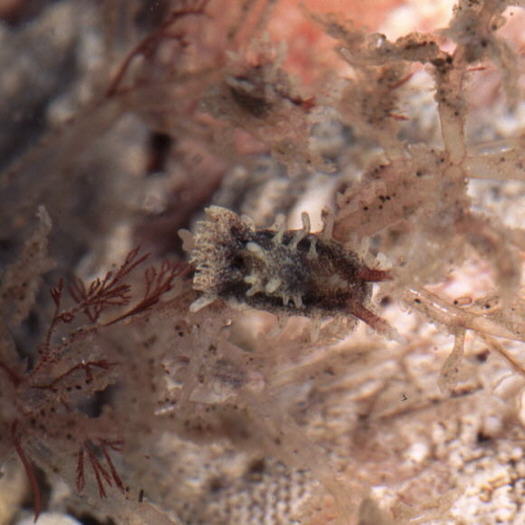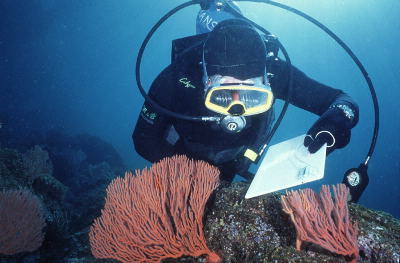 |
Polycerella glandulosa on Zoobotryon
Polycerella glandulosa Behrens & Gosliner, 1988
Last weekend (16 September 2001) Mike Miller and I were diving at the La Jolla Shores. It was a particularly warm dive, even for sunny California. The temperatures above and below the thermocline were 67 degrees and 63 degrees F respectively (maximum depth 68 feet). When it had been 59 degrees F the week before at the same depth, one can appreciate our gratitude! What made this a particularly memorable dive was not just the 35 cm long box jellyfish (Carybdea marsupialis) that we saw at 50 feet (I wrote on my slate, Mike, you touch the next one, and his expression through face mask and regulator was some sort of an expletive NO!). What made it memorable was finding one of the smaller, incredibly well camouflaged nudibranchs along our coast. Although I have seen this species fairly commonly in the Gulf of California (at Bahía de los Angeles), I had never seen it in California.
In their original description of Polycerella glandulosa, Behrens and Gosliner commented that it was abundant along the southern California coast from Morro Bay to San Diego, in late 1982 and throughout 1983. It is obviously an extremely sporadic species; records since then apparently have not been that common. I have not seen it in 20 years of diving at the La Jolla shores; however, at Bahía de los Angeles, I find it with a certain amount of regularity each year.
This cryptic nudibranch is usually found on the translucent bryozoan Zoobotryon; if you see a clump of this delicate bryozoan, look carefully among it for the smallish egg masses (although they are about the same size as the nudibranchs). If you see the eggs, there is a good chance you will find the nudibranch, although that is not guaranteed. I have spent a fair amount of time underwater searching fruitlessly for the slugs.
These limaciform polyceratids reach a whooping 8 mm in length. The rounded head has rounded lateral lobes. The semicircular frontal veil has 5 papillae. There are 2 extra-branchia appendages, situated posterolaterally to the branchial plume. These appendages are irregularly ramified and slightly swollen at the most distal ramus. This swelling is yellowish and glandular, and formed the morphological basis for the species name. The non-retractile rhinophores are perfoliate with 3-4 lamellae. The basic animal's coloration is translucent white to cream. There are subepidermal brown streaks and blotches on the back, along with yellow-white and dark brown specks. Dave and Terry's original description also present photographs of the living animal, along with a masterful line drawing, and their standard high quality diagrams of internal organs and SEMs of the radula.
Mike's photographs of this animal emphasis how cryptic it is; one also shows the egg mass, but they are almost as cryptic in the photograph. In real life, the egg mass is more visible. It is creamy white, and has the appearance (and approximate size) of a small fingernail clipping.
Regardless, this is a beautiful animal in its own dirty white way!
Dr. Hans Bertsch
Imperial Beach, Calif
Sept. 2001
Reference
Behrens, David W., and Terrence M. Gosliner. 1988. The first record of Polycerella Verrill, 1881, from the Pacific, with the description of a new species. The Veliger 30 (3): 319-324.
Taxonomy text courtesy of Dr. Hans Bertsch
Underwater photo of Hans at Bahía de los Angeles

|
Assoc. Prof. |
